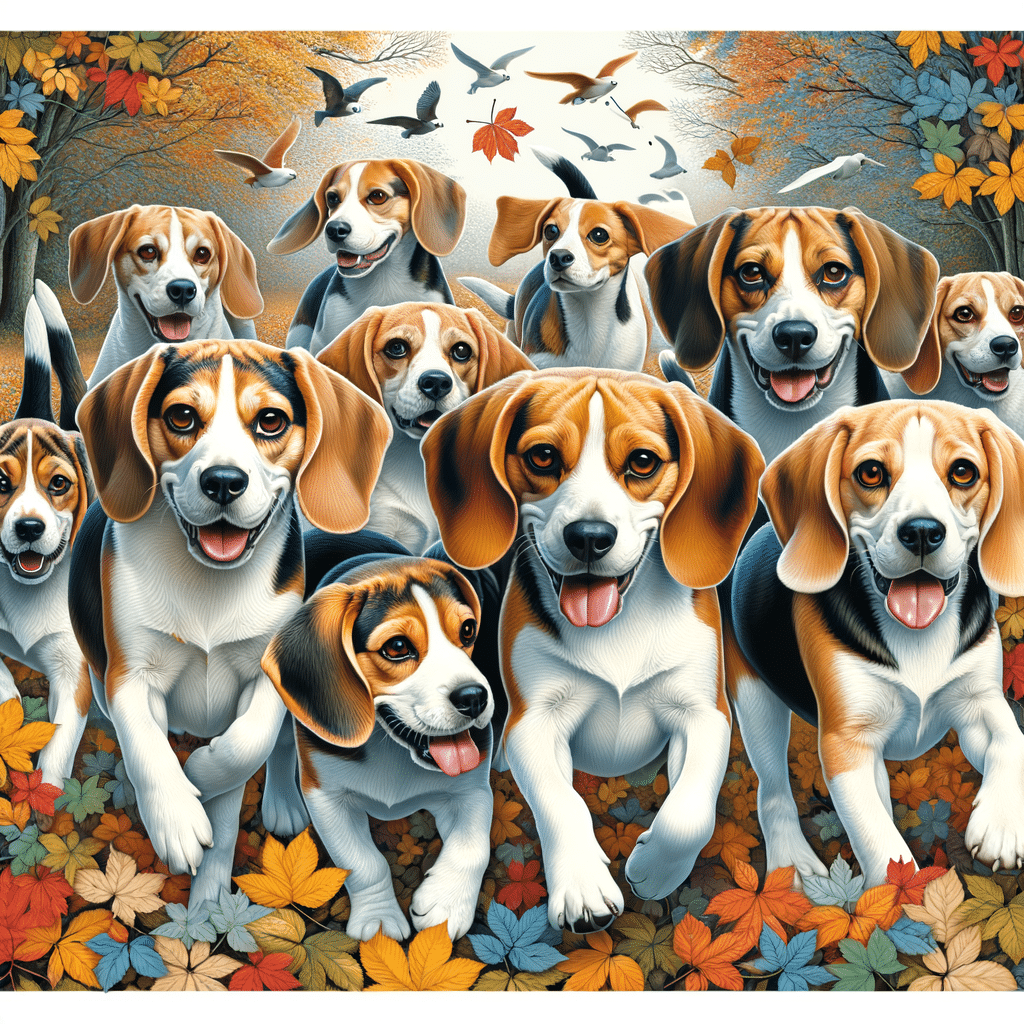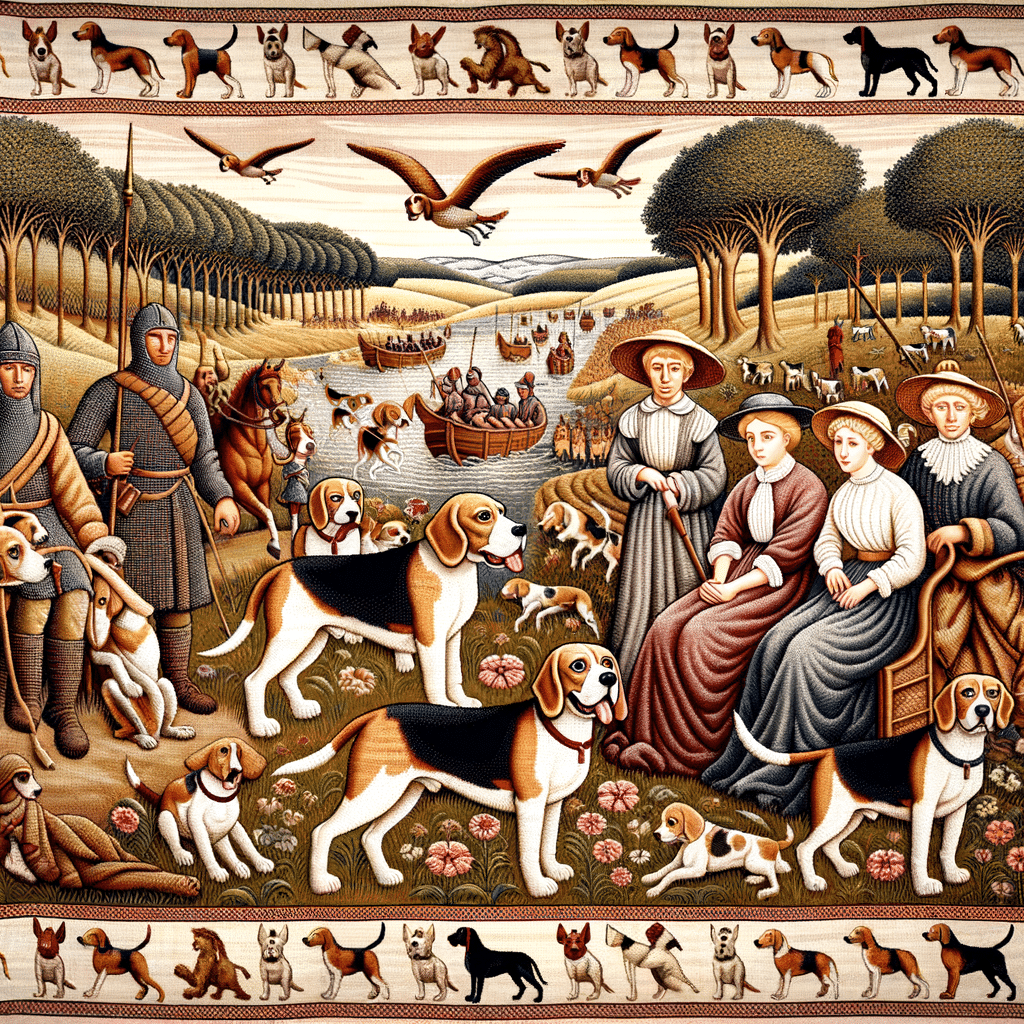Beagles and Alaskan huskies are popular breeds with rich histories and tell-tale characteristics. Originating in the United Kingdom, beagles were bred to hunt small game, thanks to their acute sense of smell and hardworking nature.
In This Article
On the other hand, the Alaskan husky is rooted in the United States and is known for its strength and endurance, which help it with the demanding work of sled-pulling. This beagle vs. Alaskan husky breed comparison highlights everything you need to know about these beloved breeds.
Both breeds have unique physical characteristics and behaviors that cater to different lifestyles and preferences. The beagle is a small to medium-sized hound with lots of smarts and a friendly demeanor, making it an excellent family pet.
Alaskan huskies are larger than beagles and have a powerful build that makes them ideal for sled-pulling and other heavy-duty work. Despite their differences in size, both breeds share a similar lifespan. Potential owners should note that huskies might have more substantial exercise needs due to their energetic nature, and beagles often prefer their independence, which can influence dog training methods.
Highlights
- Beagles and Alaskan huskies have diverse breed histories suited to different tasks, like hunting and sled-pulling.
- Physical and behavioral traits of beagles versus Alaskan huskies can cater to different owner preferences.
- Potential dog owners should consider both breeds' exercise needs and training approaches based on differences in behaviors and temperament.
Breed Origins and History
The beagle and the Alaskan husky have different histories, shaping the breeds into what they’re best known for today.
The Beagle’s English Roots
Beagle dogs originated in England and have a history that can be traced back to the Roman era, although the modern breed was developed in the 1830s. Beagle dogs were primarily bred for hunting, especially small game, with the breeding process helping develop their strong sense of smell and tracking instinct. The dog breed also has a lot of stamina, which is good news for hunters who bring their pups on extended hunting trips.
Alaskan Husky’s Working Heritage
Alaskan husky dogs were developed in the United States, particularly in Alaska, for their working capabilities. They’re technically a blend of Siberian husky, Inuit dogs, and various European breeds, all of which cater to their endurance, speed, and ability to adapt to harsh Arctic conditions. Their primary role is as a working dog that pulls sleds.
Comparative Development
Beagles were refined over centuries in England to perfect their hunting abilities, where scenting and size were necessary. Meanwhile, Alaskan huskies were not bred for looks or to match any standard but instead evolved to adapt to their working environment. Their lineage includes various breeds that contributed to the Alaskan husky’s performance in sled racing.
Physical Characteristics
These two breeds have very different physical characteristics, including sizes, coats, and health.
Size and Build Comparison
The Alaskan husky typically stands six inches taller than a beagle, with a sturdier build. In terms of weight, the Alaskan husky can be about 30 pounds heavier than a beagle dog.
Beagles are considered a small to medium breed, usually weighing between 20 and 25 pounds and standing about 3 to 16 inches tall at the shoulder. In contrast, an Alaskan husky is a medium to large breed, often weighing between 40 and 60 pounds and ranging from 23 to 26 inches tall.
Coat Colors and Patterns
An Alaskan husky’s coat can include various colors, like black, grey, white, and red, sometimes with patterns similar to that of their Siberian husky relatives. This popular dog breed needs strict grooming to keep their longer coats healthy. Beagles also feature a mix of colors, such as white, black, and tan. Their coats are notably short and dense, suitable for various climates.
Typical Health and Lifespan
The lifespan of beagles and Alaskan huskies is similar, with both breeds typically living between 10 to 15 years, depending on their health and care. Notably, beagles are prone to specific health issues such as epilepsy, hypothyroidism, and disk diseases, while Alaskan huskies may encounter hip dysplasia and progressive retinal atrophy. Regular veterinary care and proper diet play important roles in managing their health.
Temperament and Behavior
When comparing these popular dog breeds, it’s important to note that while both breeds are known for their friendliness, they each have personality traits and behaviors that might influence their adaptability in a family setting.
Beagle’s Personality Traits
The beagle is renowned for its loving and gentle nature. It often forms strong bonds with family members. Beagles are inherently friendly, making them excellent companions for children and families. However, they can be stubborn, so lots of patience during dog training is key.
Personality Highlights:
- Loving and affectionate
- Friendly with children and other pets
- Can be stubborn to train
Alaskan Husky’s Disposition
The Alaskan husky is an intelligent and independent breed known for its energetic personality. These dogs were bred for endurance and strength, which is important for their traditional role as sled dogs. This also means that they require regular exercise. Alaskan huskies are often quite friendly and enjoy being part of the family, but their independent nature might make them less likely to look for frequent attention.
Personality Highlights:
- Independent, yet enjoys family time
- Needs ample exercise due to high energy levels
- Smart and responds well to consistent training
Adaptability in Family Setting
The beagle and the Alaskan husky can fit well into family life, but their different characteristics must be considered. Beagles are very social and usually thrive in an environment where they receive plenty of love and attention. Their size and affectionate nature make them a good fit for children or puppies.
Alaskan huskies can be independent, so they might be better suited for families that aren’t home often and don’t mind having a dog who likes to curl up by themselves instead of right next to their humans. They can also be wonderful companions for families or individuals who love outdoor activities.
Family Adaptability Highlights:
- Beagles: Excellent with children, thrive on companionship.
- Alaskan huskies: Great for active families but may need training to match family dynamics.
Care and Maintenance
Caring for a beagle or an Alaskan husky to maintain dog health requires understanding their exercise, grooming, diet, and socialization needs.
Exercise Requirements
The beagle is an energetic breed that needs regular exercise, like brisk walks or play sessions, to maintain health. They enjoy outdoor activities and can become destructive if bored. An Alaskan husky is often high-energy, so they need plenty of exercise. They are ideal companions for long runs, hiking, and other strenuous activities. A lack of proper exercise can lead to behavior issues.
Grooming Needs
Beagles have short coats that are relatively low-maintenance, so regular brushing can keep shedding manageable. They rarely need baths — only when dirty — which helps maintain natural skin oils.
An Alaskan husky has a thicker coat that needs more attention, including regular brushing to minimize shedding. Due to their double coats, they go through seasonal shedding and may require more frequent grooming during these periods. Owners should bathe them occasionally, but not too often, to avoid skin irritation.
Diet and Nutrition
Beagles have big appetites and can quickly become overweight if their diet isn’t monitored and balanced. Keep a regular feeding schedule of dog food every day to prevent overeating. An Alaskan husky needs a high-calorie diet to match their energy output, especially in colder climates. Maintain a consistent feeding routine with the right balance of protein and fats.
Training and Socialization
Beagles are intelligent but can be stubborn, so patience during training is vital. Positive reinforcement methods work well. Early socialization is essential to developing a well-mannered dog. Training an Alaskan husky can be challenging due to its intelligence and independence. Consistent training and positive social experiences keep it well-adjusted and disciplined.
Frequently Asked Questions
Future dog owners might find these commonly asked questions about breed differences helpful when choosing between a beagle and an Alaskan husky.
How do the temperaments of Beagles compare to those of Alaskan huskies?
Beagles are known for their friendly and curious nature, making them great companions for children. They can, however, have a strong drive to hunt and love exploring the outdoors. Alaskan huskies are also friendly and child-friendly, but with their sledding heritage, they have a strong pack mentality and can be more independent.
What is the typical cost range for purchasing a Beagle versus an Alaskan husky?
The price of a beagle typically ranges between $400 and $1,200, depending on the breeder’s reputation and the dog’s lineage. An Alaskan husky, a less common breed often used for work purposes, can vary greatly in cost, starting from around $1,000 to over $2,500.
Can an Alaskan husky be a suitable pet for indoor living?
An Alaskan husky can adapt to indoor living if it’s given ample exercise and mental stimulation. Due to its high energy levels, Alaskan huskies need vigorous daily physical activity. A lack of exercise can lead to destructive behavior due to pent-up energy.
How do Alaskan huskies differ from Siberian huskies?
Alaskan huskies are primarily bred for working capabilities rather than appearance, which makes them vary in size and coat. Siberian huskies are purebreds recognized by the American Kennel Club and are more consistent in size and appearance. Siberians are known for their striking looks and are often smaller and less strong than Alaskan huskies.
What are the parent breeds of an Alaskan husky?
Alaskan huskies come from various breeds, such as the Siberian husky, Alaskan malamute, German Shorthaired Pointer, and others. Their breeding patterns help give them desired traits such as speed and endurance in sled pulling.






